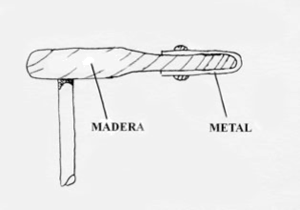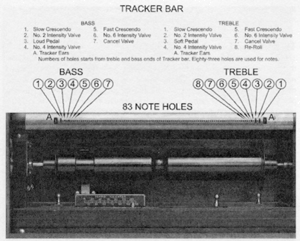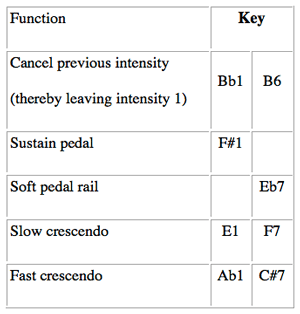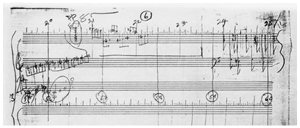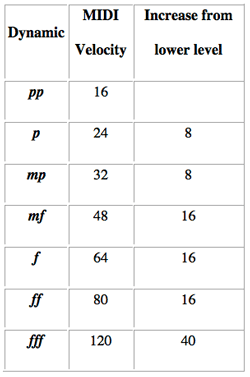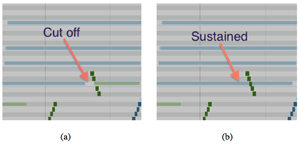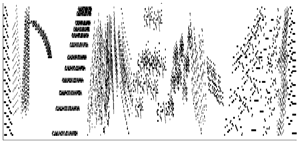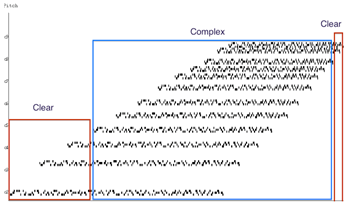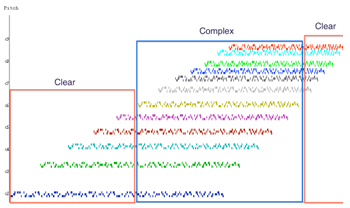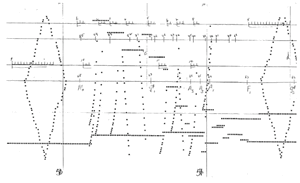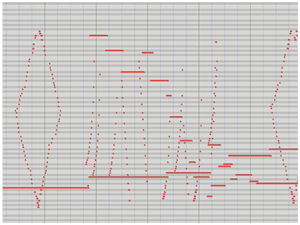The Editing and Arrangement of Conlon Nancarrow’s Studies for Disklavier and Synthesizers
Robert Willey
KEYWORDS: Conlon Nancarrow, MIDI, synthesis, Disklavier
ABSTRACT: Over the last three decades a number of approaches have been used to hear Conlon Nancarrow’s Studies for Player Piano in new settings. The musical information necessary to do this can be obtained from his published scores, the punching scores that reveal the planning behind the compositions, copies of the rolls, or the punched rolls themselves. The most direct method of extending the Studies is to convert them to digital format, because of the similarities between the way notes are represented on a player piano roll and in MIDI. The process of editing and arranging Nancarrow’s Studies in the MIDI environment is explained, including how piano roll dynamics are converted into MIDI velocities, and other decisions that must be made in order to perform them in a particular environment: the Yamaha Disklavier with its accompanying GM sound module. While Nancarrow approved of multi-timbral synthesis, separating the voices of his Studies and assigning them unique timbres changes the listener’s experience of the “resultant,” Tenney’s term for the fusion of multiple voices into a single polyphonic texture.
Copyright © 2014 Society for Music Theory
1. Introduction
[1.1] Conlon Nancarrow’s compositional output from 1948 until his death in 1997 was primarily for the two player pianos in his studio in Mexico City. Until 1985, when his compositions began to be played on other instruments, the only way to hear his work was on recordings.(1) Beginning in 1985, with Clarence Barlow’s sequencing on a Marantz Pianocorder, followed in 1986 by my work with Rick Bidlack on a Yamaha Disklavier and Jürgen Hocker’s restoration of an instrument with an Ampico (American Piano Company) mechanism, audiences could hear Nancarrow’s Studies performed “live.” This article presents examples of the arrangement of selected Studies for player pianos and synthesizers. I will consider arrangements by Barlow, Trimpin, and Martin Schlumpf, along with my own work which involves editing and arranging MIDI data of selected Studies for Yamaha’s Disklavier player piano and its accompanying synthesizer module.
[1.2] An alternative approach involves live performance on acoustic instruments. Musicians such as Yvar Mikhashoff, and later his students Helena Bugallo and Amy Williams, arranged some of the more manageable Studies for one or more pianists in order to expand the repertoire and incorporate human expression. Nancarrow was not opposed to live performance of his works as long as the pieces were played well. He had chosen to compose primarily for player piano after unsatisfactory experiences with musicians who were unable to play his music accurately, and he stuck with it over the years as his interest in flexible time grew.
[1.3] The approach to composition of defining a list of notes (in Nancarrow’s case punching them on a paper roll) that specify pitch, timing, and duration, which are then played on an instrument of one’s devising (in his case, on a piano with hardened hammers) was similar to the first computer music programs Max Mathews started developing in 1957 at Bell Laboratories. Mathews’ series of Music N computer music languages divided input into specifications of virtual instruments and a list of notes to be played on them. This approach of using one mechanism to store data and another to perform it was repeated in 1983, with the specification by synthesizer manufacturers of a computer music system designed for consumers: the Musical Instrument Digital Interface. A MIDI sequencer performs the function of the player piano’s punched roll, and a MIDI synthesizer replaces the piano.
[1.4] MIDI is a natural environment to study and realize Nancarrow’s compositions because it is so similar to the way a player piano makes music. It also has some advantages over punched rolls. Note messages are stored in the digital memory of a computer instead of being punched on paper, making them easier to enter, edit, copy, and share. MIDI also has 16 different channels, the timbres of which can be set up with program changes. Once the data from Nancarrow’s compositions is converted to MIDI format the arranger must decide what acoustic or electronic instrument to use to play it, and how to set it up. This article deals primarily with the process of converting the information controlling dynamics on the rolls into MIDI data, and the issues that are involved in setting up instruments to play it on.
2. Nancarrow’s Instruments
Figure 1. Piano 1, with wood surrounded by felt, covered with a leather strap, and finished with a metal fastener (Sandoval 2012)
(click to enlarge)
Figure 2. Piano 2, with wooden hammers finished with a metal strap (Sandoval 2012)
(click to enlarge)
Example 1a. Excerpt from Study No. 41b, played on strident Piano 2 (Arch recording)
Example 1b. Excerpt from Study No. 41b, played on more mellow Piano 1 (Wergo recording)
[2.1] Information about Nancarrow’s instruments provides important context for decisions about the editing and arrangement of his works. Nancarrow experimented with a number of approaches to intensify the rhythmic effects he could get from his instruments. He tried constructing a percussion orchestra that could be controlled by piano rolls, but was never able to solve the engineering problems to supply sufficient air pressure. He was interested in a “mandolin” attachment that can be dropped between a piano’s hammers and strings, giving it a tinny tone. Unfortunately the device did not work during high-speed passages. Next he hardened the hammers of his piano by soaking them in shellac but was not satisfied with the result. Finally he settled on the two types of metal preparations for his two instruments that are heard on his recordings. These are shown in Figures 1 and 2, and described in an interview with William Duckworth (1995, 46):
One [Figure 1] has the regular hammer on the piano covered with a leather strip that has a little metallic thing at the striking point. . . .It still has the cushion of the regular hammer plus the metallic thing. It’s not a harpsichord, but it’s vaguely in that area. The other one [Figure 2] is very, very aggressive and hard. It has wooden hammers, pure wood, covered with a steel strip. In order to avoid having the wooden hammer break strings at high volume levels, the soft pedal on this instrument was kept depressed in order to shift the hammer rail closer to the strings, thereby decreasing the velocity of the attack.
[2.2] Nancarrow told Hocker (2012b, 18–19) that the nature of the preparations was not so important, as long as the hammerheads were hard so that the attack portion of notes was emphasized, in order to maximize the clarity of polyphonic voices during very complex, rapid sequences. Nancarrow was attracted to the harpsichord’s sound and the definition of notes created by its plucking mechanism. Unfortunately it was not practical for his purposes, as even if there were player harpsichords they would require frequent tuning (Duckworth 1995).
[2.3] In general Nancarrow preferred the characteristics of his less aggressive piano, the instrument whose hammers included a layer of felt (Figure 1). He was flexible though as to the choice of instrument on which to perform most of the Studies. “When I compose I have in mind a specific piano. However, many of the pieces are more or less interchangeable, without suffering too much” (Fürst-Heidtmann 2012). The difference between the two can be heard on the Arch (1977) and Wergo (1999) recordings of Study 41b; excerpts are provided in Examples 1a and 1b.(2)
3. The Rolls and Ampico Mechanism
Figure 3. Photograph of tracker bar from an Ampico mechanism (Hocker 2012b)
(click to enlarge)
[3.1] Nancarrow owned reproducing pianos, which offered higher levels of expression and control than standard player pianos. His pianos were each fitted with an Ampico mechanism with a tracker bar that reads 98 tracks across the width of the paper roll, as shown in Figure 3. As the roll passes over it, a hole punched in the paper will allow air to be sucked through a hole in the tracker bar, causing the corresponding key on the piano to play. Tracks 8–90 are used to play the piano’s 83 keys rather than the full 88, making the bottom two and top three notes unplayable. The keyboard is divided into two zones: the bass from B1 to E3, and the treble from F3 to A6. Air pressure determines the volume, and it is independently controlled for each zone; tracks 1–7 controls the bass pressure/volume and tracks 90–97 controls the treble pressure/volume (Figure 3). A punch in track 98 rewinds the roll after the music has ended. In addition to the superior control over dynamics, reproducing pianos replaced the foot pedals that operators pumped to create a vacuum with an electric motor, resulting in a more constant rate of playback, a feature especially important for Nancarrow, considering his passion for exploring tempo changes.
Table 1. Dynamic levels are controlled by punching single or combinations of holes in the margins of the rolls
(click to enlarge)
Table 2. Additional tracks in the margins used for other functions
(click to enlarge)
[3.2] The Ampico was engineered to produce seven levels of intensity (see Table 1). Intensity 1 is obtained by cancelling any previous dynamic level. Intensity levels 2 and 3 each are indicated with a single punch. For example, the dynamic of p for the bass zone is created by punching a hole in Track 2 below the range of sounding notes, where F1 would be. A hole at Track 85 (above the range of sounding notes) is used to set up a p dynamic for any subsequent notes in the treble range. While Intensity 4 can be obtained by punching A1, Nancarrow preferred using the alternative method of punching the combination of notes F1 and G1 together. A punched dynamic is supposed to latch and remain in effect until the next one is read, but Nancarrow occasionally repeated the dynamic, perhaps to ensure the response from a mechanical system that might malfunction (Willey 2012b). Nancarrow did not use the capabilities of the pianos to produce crescendi, and only rarely engaged the sustain pedal. At times (such as in Study No. 21) the soft pedal is used, bringing the hammers closer to the strings. Table 2 indicates the tracks for additional functions in the Ampico mechanism.
4. Copying the Rolls
[4.1] One option for those interested in “live” performances of Nancarrow’s studies is to use the original rolls or copies of them.(3) For his European concerts of Nancarrow’s Studies in 1988–89 Jürgen Hocker obtained some rolls from Nancarrow and repunched others from photocopies. (I will discuss the use of the rolls and photocopies for editing and arrangement below.) Wolfgang Heisig sells copies of rolls he punched using a graphic editing program that is able to draw in notes with complete temporal freedom, down to the smallest 1/20 millimeter punchable step (Willey 2012a). Dominic Murcott presented Nancarrow’s Studies on an authentic instrument from copies of the rolls as part of a centennial celebration at the Southbank Center in London in 2012 (see Murcott 2014).
5. MIDI Data from Published Scores
[5.1] While MIDI was intended to communicate control information generated by human performers, it is sufficient to represent Nancarrow’s music, even when passages reach 110 notes per second.(4) Once his compositions have been converted to MIDI data they can be used with a wide variety of software and hardware and are no longer limited to a single type of instrumental sound in a fixed location. The data can be generated in a variety of ways. The first, available to anyone, is to read the published scores and enter the notes into a MIDI sequencer. Nancarrow punched the first twenty Studies using a conventional hole-punching machine whose ratchet allowed him to advance the roll only in thirty-second note increments. These Studies can be entered into standard MIDI sequencers in step-recording mode since they share a common subdivision. After Study No. 20 Nancarrow had his punching machine modified so that he could advance his rolls by any amount, thereby making it possible for the voices to proceed independently at different tempi (Hocker 2012b).(5) The change was immediately evident in Study No. 21 (Canon X), where the lower voice starts out slowly and gradually accelerates while the treble does the reverse. Arrangers working from scores of the later Studies must now turn to custom software solutions.(6)
[5.2] Most of Nancarrow’s compositions include canonic elements, and some follow the method strictly. Study No. 37 is a series of twelve canons in twelve voices, with each in a different tempo(7). I generated MIDI data for Study 37 with the aid of the PLAYER program, designed by Gareth Loy at the Computer Audio Research Laboratory at the University of California San Diego. The MIDI data was then performed on 16 channels of Yamaha FM synthesizers piped to four audio channels (Willey 2012c).
[5.3] Other musicians have MIDI data generated from reading scores to control acoustic instruments. Clarence Barlow was the first to perform Nancarrow’s music on MIDI-controlled pianos, at a live concert in the chamber music hall of Cologne Radio (WDR) in May of 1985. He typed in the information note by note for Studies 5, 7, 19, and 21, which were then performed on a Marantz Pianocorder. As his sequences are multi-track, with each voice on a separate channel, the Studies can be performed on two or more player pianos arranged on opposite ends of the hall at one time, while panning notes between them. The same note is played on both instruments, but in order to pan it towards one side a key on one piano is assigned a higher velocity, and the same note on the other instrument with a lower velocity, in the same way that audio signals can be panned between pairs of speakers. Since then Barlow has used other systems, including a Bösendorfer 290SE, Trimpin’s Vorsetzer, an Autoklav, various Yamaha Disklaviers, and a PianoDisc. He found the Marantz system to be robust but not as sensitive to dynamic changes (Email correspondence, September 21, 2012). Trimpin’s system was better in that regard, and the early Disklaviers, being designed for what a human can do with ten fingers, would sometimes bog down during extremely rapid passages—as when the piano reaches 110 notes per second in Study No. 21. Rick Bidlack determined the algorithm behind Study No. 21 in 1986 and played the output of his computer program on a Disklavier at the Center for Music Experiment at the University of California, San Diego.(8) Trimpin has performed some of the Studies on a variety of acoustic instruments, including a percussion orchestra, Dutch wooden shoes, prepared pianos, and xylophones (Gann 1995, 271).
6. MIDI Data from Rolls
[6.1] The published scores, which were produced from handwritten clean copies, do contain pitch errors (see Nemire 2002), and even though they use proportional spacing there may not be enough timing information to create a MIDI sequence. Thus, MIDI data for the Studies can also be generated by examining the “punching scores” or the rolls themselves, or Xerox copies of them.
Figure 4. An excerpt from the punching score for Study 49c
(click to enlarge)
[6.2] Nancarrow’s first step in composing was to spread out a section of piano roll paper and mark off subdivisions of beats at the desired tempo for each voice, using one of the thousand strips of cardboard templates he kept in a cabinet by his drafting table. The second step was to transfer these tempo scales to conventional music paper. The third step was to create a “punching score” on this music paper on which he wrote beat numbers, dynamic markings, pitches, and anything else he would need to punch the rolls (see Figure 4).
[6.3] Many researchers regard the punching scores as the best source of information for analyzing the compositions.(9) Martin Schlumpf (2004) created the MIDI files for his Die Kunst des Tempokanons CD from studying the punching scores at the Paul Sacher Stiftung. The punching scores have the multiple tempo scales mapped out in pencil, and were used by Nancarrow as references while punching the rolls, but Trimpin explains that Nancarrow did not always follow them exactly, and made changes when he got to actually punching the rolls and playing back sections as he went along:
He would lay out the tempo structure first in pencil on the paper roll, and then transcribe from the punching score onto the paper roll. The timing information on the punching score was not accurate. You see the pencil marks for all the voices on the paper roll. Sometimes he taped over mistakes with Scotch tape and started punching again. There was a lot of editing going on while he was punching. He worked more from the roll. He would listen to one voice, start to sketch out the next, start to punch, and if he saw something wasn’t right, he would tape over it with Scotch tape. (Willey 2012b)
In the end, the composition results in a punched roll of paper, which precisely indicates pitch, timing, and dynamics. Trimpin believes that the best method for creating MIDI files is to work from data derived from the rolls themselves, as neither the punching score nor the notated score always reflect Nancarrow’s final intentions.
[6.4] Trimpin built a pneumatic scanner to convert the rolls to MIDI data.(10) The pneumatic scanner works analogously to the tracker bar of a player piano, sucking air through the holes that pass as the roll is wound onto an Ampico spool, thereby incorporating the accelerando that naturally occurs at the end of longer Studies, as the diameter of the wound-up paper gradually increases, a feature that is not present on the punching and notated scores. The MIDI data that was recorded on his computer can then be played back on any MIDI-compatible device.
[6.5] The Appendix to this article provides detailed information about the editing of MIDI data produced by Trimpin’s scanner. Issues addressed in the Appendix include the speed, scanning errors, and apparent irregularities in the data.
7. Adjusting the Data
Dynamics
Table 3. One possible translation of Ampico dynamics to MIDI velocities for performance on a synthesizer
(click to enlarge)
Table 4. Trimpin’s translation to MIDI velocities for performance on acoustic pianos using his Vorsetzer
(click to enlarge)
[7.1] Nancarrow wrote terrace dynamic changes in his scores, but the difference between neighboring levels such as mp and mf are not always clear in the recordings. According to Trimpin, “He wasn’t that interested in dynamics. If you listen to the recordings there’s not a big difference. Sometimes you can hardly hear it” (Willey 2012b). The Ampico piano had 7 levels of intensity, while MIDI offers 127 gradations of velocity. One possible conversion scale of Ampico dynamic levels to MIDI velocities starts pp at a value higher than 1 and then spreads the remaining 6 dynamic levels p, mp, mf, f, ff, and fff evenly over the remaining MIDI velocity range. For example, Table 3 sets pp to a MIDI velocity of 37 and fff at 112, with a rise in velocity of 15 between successive steps. The velocity translation for fff is not set at the maximum possible since a velocity of 127 (which would be the maximum) can be too harsh on some player pianos. The difference of level of 15 between velocities on a MIDI synthesizer, however, may be more dramatic than what one hears with the Ampico. The lowest dynamic level pp could be lowered for synthesizer playback below 37 in order to take advantage of a wider dynamic range, but the jump from one dynamic to another would become even more dramatic if fff were left at 112.
[7.2] Trimpin (1992c) bases the values for his translation of MIDI velocities (Table 4) on empirical experience with nonlinear mechanical instruments, with smaller jumps in velocity levels between pp and mp (an increase of 8 each time) than from those between mp and ff (an increase of 16). In this scheme he jumps 40 from ff to fff.
[7.3] Trimpin (Willey 2012b) explained that the dynamic range that Nancarrow used has to be scaled for each type of piano: “Every piano is different. You have to find the lowest velocity that makes the key go down. If a velocity of 5 makes the key go down, then that becomes the velocity you use for Intensity 1. Asian pianos are weighted with approximately 52 grams, European pianos a little heavier, around 65 grams.”(11)
Pitch
[7.4] Nancarrow was usually strict about the imitation of canonic voices, so previous entries of a voice can be used for comparison when the material returns in later voices. There are places in the Studies where he could not strictly follow the canon’s first appearance, as the sequence of intervals of its return would put the notes outside the range of the 83 notes of the Ampico system. It is left to the arranger to decide whether to take advantage of the wider range of pitches when performing on other instruments, following a strict transposition and changing the notes rather than dropping up or down an octave as Nancarrow had to do.(12)
Figure 5. (a) Original, before editing, with the interruption of a sustained note. (b) After editing, the note is held out on the “blue” MIDI channel and the same pitch played on the “green” channel as part of the run.
(click to enlarge)
[7.5] New questions may arise for the arranger during the process of separating the data into separate tracks for MIDI performance. Unlike a player piano, synthesizers can play the same note on two different voices. At times Nancarrow is forced to cut a sustained note off prematurely in order to make the key available to be played by a different voice. For example, in the piano roll data shown in Figure 5a, Nancarrow has cut off a sustained, then played it as a member of a run and then allowed it to ring with the rest of the chord of which it was at first a member. If this is played on a synthesizer the long note can be held on one channel and the short note played over it. Depending on the envelopes of the synthesizer patch being used this could make a difference. For example, if a clarinet patch with a long sustain were being used for the “green” channel below, sustaining the middle note in the run would stand out much more than if it sounded on the piano. In this situation it seems appropriate to change the duration of the note that was cut off to be as long as we imagine Nancarrow would have sustained it, had it been an option, and then assign the run to a different channel (Figure 5b).
Timbre
[7.6] Once the data has been edited, one must decide whether to emulate the type of sound produced by Nancarrow’s modified pianos or depart from it and use new synthesizer timbres. If the MIDI data for each voice has been separated on a different track in the sequencer, each track can then be assigned a different MIDI channel and panned position.
[7.7] Jürgen Hocker played copies of Nancarrow’s piano rolls on an Ampico Bösendorfer grand piano, using a second hammer rail fitted with hardened hammers for use with Nancarrow’s music in live concerts (Hocker 2012b, 17). When heard on his 2005 recordings, however, the hammer attacks of his piano are not as clear as either of Nancarrow’s pianos. The lack of definition in the attacks may have been affected by placing the microphones further away, recording the piano in a more reverberant space, or using a grand piano (with a different orientation) instead of an upright. When I play the Studies on a Disklavier I am not able to harden the hammers, so I double parts with the instrument’s companion synthesizer module using percussive synthesizer patches with sharp attacks in order to add a "ping" like that produced by Nancarrow’s modified Ampicos. Examples 2a–c provide excerpts from the Study No. 25 in the 1750 Arch Recordings (Nancarrow 1977), Hocker’s arrangement (Hocker 2005) and my arrangement for Disklavier and synthesizer.
Example 2a. Study No. 25, excerpt from the 1750 Arch Recordings (Nancarrow 1977)
Example 2b. Study No. 25, excerpt from Hocker’s (2005) CD
Example 2c. Study No. 25, excerpts from arrangement by the author for Disklavier and synthesizer
[7.8] Today, the Yamaha Disklavier is the most widespread brand of player piano. It comes in a range of models and sensitivities, from uprights to high performance grands. When synthesizing Nancarrow’s music for synthesizers alone I use mostly patches with percussive envelopes, like harpsichords, which Nancarrow thought would be suited to his music because they clarify lines. When asked why he prepared the hammers on his pianos, Nancarrow responded, “for the same reason that Bach sounds so much better on harpsichord than on piano. The piano is basically a homophonic instrument” (Fürst-Heidtmann 2012).
[7.9] Yvar Mikhashoff was one of the first to arrange some of Nancarrow’s Studies for piano, as well as for other instruments. He learned that Nancarrow had composed many of the early Studies with instruments in mind, while later studies, with their melodic lines extending across six or seven octaves, were realizable only on the player piano. According to Mikhashoff, Nancarrow suggested these principles: “Strong preference given to oboe, horn, and trumpet, and the other winds; general avoidance of prominent flute or strings soloistically; and an awareness of the instrumentation trying to preserve some of the attack properties of the player piano” (Metzmacher 1993). Nancarrow didn’t mind if people arranged his music as long as the temporal aspects were realized accurately.
Ambiance
[7.10] In addition to selecting timbres and spatial location for new arrangements, the arranger must decide how much reverberation, if any, to use. Nancarrow’s studio was soundproofed and loaded with rolls and instruments. Bob Shumaker, the recording engineer for both the 1750 Arch Records and Wergo sessions, describes the acoustics in the studio: “The room was pretty dead, and the pianos were loud and clear. Too much room ambience would clutter the music because of its complexity and density” (Email correspondence, May 31, 2011).
[7.11] Pianos do not normally have dampers on the top one and a half octaves. Allowing the highest strings to vibrate sympathetically in response to the vibrations of the lower strings increases the instrument’s resonance. In order to maximize the polyphonic clarity of his lines, Nancarrow modified the apparatus of his upright pianos to include dampers on all the strings, reducing the ringing of the top strings and the sustain of rapid staccato passages played in the highest register (Hocker 2012b). This preparation combined with the dry acoustics of his studio have prompted me to apply minimal reverberation in my synthesized versions.
8. Multi-timbral and Mono-timbral Arrangements of Studies 37 and 11
[8.1] During the composition of some of the Studies Nancarrow was imagining the different voices being performed with different instruments. When he finished, however, the performance took place on his pianos where there was no such timbral difference between the voices, and the feedback he received from listening to each one informed the next work. James Tenney, whose landmark analysis accompanied the 1750 Arch Recordings and subsequent Wergo series, created the term "resultant" to describe a special effect created by Nancarrow’s Studies:
I mean by this a complex but perceptually singular “layer” or stratum in the polyphonic texture, produced by a combination and fusion of two or more rhythmically independent voices or notationally separate parts. . . .Nancarrow is a great master of compound polyphony—possibly the greatest since Charles Ives and it is this aspect of his work that intrigues me the most. . . . The two most distinctive characteristics of Nancarrow’s work as a whole are his rhythmic procedures and his exploration of manifold varieties of polyphonic texture—and polyphonic perception . . . the second . . . may one day be seen as the area of his greatest achievement—his greatest contribution to the development of our musical perceptions. (Tenney 1999)
Figure 6. Assigning a different timbre to each of the 12 voices makes them easier to hear, as colorizing the notes in a sequencer view makes them easier to see
(click to enlarge)
Figure 7. The second, mono-timbral version, with all 12 synthesizers playing all 12 voices in unison
(click to enlarge)
Figure 8. Mono-timbral version of the fifth canon in Study No. 37
(click to enlarge and listen)
Figure 9. Multi-timbral version of the fifth canon in Study No. 37
(click to enlarge and listen)
[8.2] When Nancarrow heard my multi-timbral version of Study No. 37 at the University of California, San Diego, in 1986, he said that it was the first time his music had been improved over the original. In that version each of the 12 voices of the Study were played by a different synthesizer, panned to a unique position in the quadraphonic sound field. This made it easier for the listener to maintain their awareness of the 12 voices, as does coloring the notes by channel in a MIDI sequencer (Figure 6).
[8.3] But then I played him a second version, with all 12 synthesizers playing all the voices in unison. It created a monolithic sound spread around a quadraphonic sound field, and Nancarrow said he preferred this new mono-timbral version over the first multi-timbral one. When all voices are played with the same instrument (whether 12 synthesizers playing in unison or a single player piano) the resultant Tenney described is created in dense passages in which the different voices are no longer individually perceivable. The same sort of confusion is created visually (Figure 7) when it becomes harder to differentiate the voices when all the voices appear with the same color.
[8.4] The staggered entrances of the 12 voices in the 12 canons in Study No. 37 make it easy for the listener to distinguish them. How long they are able to continue to follow them changes depending on whether all voices are played by the same instrument or by different instruments. The fifth canon is shown in Figure 8 with audio from my mono-timbral arrangement. Sometime around the entrance of the fourth voice the texture thickens and the polyphony merges into a resultant, creating a complex texture in which the listener can no longer maintain awareness of all the individual voices. The complexity increases and then subsides, at which point the listener may be able to discriminate between the last 2 remaining voices.
[8.5] The listener is able to remain aware of all the individual voices longer in the multi-timbral version in Figure 9, perhaps up to the entrance of the sixth voice, and is able to return to recognizing the distinct voices earlier as well as the texture thins out at the end.
[8.6] Nancarrow was not impressed by the electronic timbres available in the 1980s: “I am not much attracted so far by electronic sounds, because I think it is not the same as live instruments. [But] it is developing. Some day we’ll have sophisticated electronic sounds” (Fürst-Heidtmann 2012). MIDI was introduced in 1983, and three years later, when Nancarrow visited San Diego I was using preset voices on Yamaha FM TX-802 synthesizer modules and a Sequential Circuits Prophet 2002 sampler with an acoustic grand piano patch to synthesize his Studies. These timbres were not as rich timbrally as what was to be available by the end of the decade in samplers like the E-mu Proteus. For his CD Die Kunst des Tempokanons, Martin Schlumpf’s instruments included a Korg 01R/W with expansion cards, a Roland XP-50 with world expansion card, a Proteus 2000, and a software plugin with samples from a Unity Sample player.(13)
[8.7] I have synthesized several versions of Study No. 11 for Player Piano using harpsichord, clavinet, piano, bass, mallets, and brass patches (Willey 2012d). Examples 3a–d provide an excerpt from the end of the piece; there are two voices that are eventually joined by two more. By the time the third voice comes in the version played on Nancarrow’s piano (Example 3a), it gets hard to maintain awareness of all three lines because they are all played with the same instrument sound in a fixed position. When synthesized with mostly harpsichord patches (Example 3b), the separation of voices is achieved more through panning than by differences in timbre. I prefer the harpsichord version because of its enlarged stereo field and full spectrum, the result of panning and layering instruments that fill out the tonal space. The two multi-timbral treatments (Examples 3c and 3d) clarify what each voice is doing, but as a result change the listener’s perception of complexity.
Example 3a. End of Study No. 11, Nancarrow’s original
Example 3b. End of Study No. 11, harpsichords
Example 3c. End of Study No. 11, multi-timbral version 1
Example 3d. End of Study No. 11, multi-timbral version 2
9. Reflections
[9.1] It is tempting to speculate on how much more music Nancarrow would have been able to produce in his lifetime if personal computers and MIDI had been available a decade earlier, and had he an aptitude for computer programming such that he could have realized his music with that more powerful technology. I estimate that the time spent on the technical aspects of laying out the time relationships on paper, creating the punching scores, and finally punching the holes could have been reduced the time required to finish a composition by at least a factor of ten. On the other hand, the methods that he developed may have been a perfect match for his thinking, and the physical process of marking each subdivision on paper and continually being faced with how they aligned with those of their neighbors contributed to the thinking that led to his breakthrough compositions.
[9.2] Recreating or editing a MIDI sequence usually for one of Nancarrow’s Studies takes a few days to a week. While working on one I get into a workflow that I imagine has something in common with Nancarrow’s, where I become involved in the process of editing and channelizing data as it is laid out graphically, and for a time lose interest in how it sounds. Arriving at the end and playing back the entire piece is exciting, more powerful than listening to a new Study from a recording, perhaps in part because of the effort involved. I believe that the time and effort required to create a roll must have made him think about what he was doing and plan it carefully. This, combined with the peace and quiet afforded by his isolation must have contributed to the composition of an unusual body of work.
[A.1] The speed that Nancarrow chose to play the Studies varied. While the motor of his Ampico player piano mechanism maintained a constant speed, its rate was controlled with a slider that varied continuously from very slow to very fast, and didn’t have the stepped increments of a metronome. Gann (1995, 30) notes that he increased the speed of seven of the Studies between the 1969 Columbia recording and the early 1750 Arch Recordings set, and then in 1990–91 slowed down about 10% for the Wergo edition. The difference in timings between the three editions suggests that Nancarrow was somewhat flexible as to what speed to use, and might therefore accept an arranger’s adjusting playback speed in response to the occasion or qualities of the instrument(s) used for playback. While transferring the rolls to MIDI files, Trimpin and Nancarrow were less concerned with the tempo the roll was being played at as they were with the accuracy of note and volume information, since the playback tempo could always be adjusted later. As a result, the duration of the MIDI files based on these scans have to be changed to match the durations of the authorized recordings. Trimpin recalled the process of adjusting the speed of the Ampico playback to arrive at the right tempo, something Nancarrow needed to do each time before making an audio recording in order to compensate for the imprecision of the motor driven reproducing system:
I remember in his studio that he had so many stopwatches lying around. I guess he lost them once in a while in a bookshelf or whatever. When he started to play a Study he had to run the whole roll to make sure that it ran at the right tempo. When it was a little too fast or a little too slow he had to adjust it and run it again. It was very time consuming. (Willey 2011)
[A.2] Trimpin gave me copies of his MIDI data, with a separate Performer file for each Study, and explained the editing process necessary to correct errors introduced by the mechanical transfer, which occurs most often during rapid passages. Trimpin recorded each Study twice, each on a separate MIDI track in his Performer file. The first step in editing the data is to pick which of the two tracks to use. A quick visual inspection is usually enough to decide which will require less editing, as one may have more obviously incorrectly sustained notes that sometimes resulted from a USB interrupt to his scanner. The selected track is then duplicated in a new sequencer track for editing, after which the original two tracks are muted and only used from then on for comparison purposes to answer questions that may arise during the editing process. As shown in Tables 1 and 2 (see paragraph [3.2]), dynamic control holes are punched in 7 tracks below and 8 tracks above the Ampico’s 83 playable notes. During Trimpin’s scanning process these control punches are converted to MIDI note commands. If the sequences are played back on a piano with 88 notes or a synthesizer with up to 128 notes these control punches will be played just like any other notes. Trimpin deletes this phantom MIDI note data, but I prefer to move it to new MIDI tracks that are then muted, so that it can be used to compare with the dynamics notated in the score when it comes time to change the MIDI note velocities. In order to make the sequence of MIDI notes the same length as the audio recording, the phantom MIDI notes must be ignored, for example, the ones used to set up the initial volume level before the first real note is played, or the one at the end used that tells the Ampico mechanism to rewind the roll after the piece finishes. The tempo of the MIDI sequence is then adjusted so that the duration of the chosen MIDI track (not counting the phantom notes) matches that of one of Nancarrow’s authorized recordings. An audio recording of the Study imported from a CD into a new audio track in the sequencer makes it easy to adjust the tempo so that the duration of the MIDI data visually match that of the audio. The roughly synchronized audio file is also useful to answer questions that may arise later during the editing process.
[A.3] The main type of scanning errors during Trimpin’s pneumatic scanning process were extraneous, repeated, or prolonged notes, which he suspects were introduced by his machine’s automatic adjusting system as it struggled to maintain alignment with paper rolls of inconsistent width and condition (Trimpin 1992a, 1992b).
Figure 10. Unaligned chords
(click to enlarge and listen)
Figure 11. After deflamming to tighten the alignment
(click to enlarge and listen)
[A.4] Sometimes notes are prolonged, especially in rapid passages. Glissandi are usually not perfectly smooth, and chords are often out of alignment, whether because they were composed and/or punched that way, or as a result of the scanning process. Because MIDI uses a serial connection, only one note at a time can be communicated through a cable. MIDI’s clock speed is such that the closest two notes can be played together is around 1 millisecond, so triads will be spread over a minimum of 3 msec (Loy 1985). Trimpin says that one can use the deflam function in Performer to perfectly align chords by selecting the notes of the chord and then giving the command to pull together all those that lie within a range of about 30 ticks (30/480ths of a beat) from each other. However he agrees that this slight error is not audible, and that Nancarrow’s chords are often not perfectly lined up on paper anyway. Trimpin said “if you look at his rolls they are never perfectly lined up.” At a fast tempo unaligned chords are not noticeable to the ear. Fine editing such as that returns limited acoustic improvement. For example, Figure 10 shows 5 triads that are not perfectly time-aligned. Figure 11 shows the result after I deflammed the chords. While they look more precise in Figure 10 there isn’t any appreciable difference in the sound. Skilled arrangers of traditional reproducing piano repertoire were able to accentuate a melody by moving it slightly ahead of its accompaniment. No consistent evidence of this technique has been observed in Nancarrow’s rolls. For example, in Figure 10, the order of notes in triads is inconsistent. The top voice plays slightly ahead of the other two in the first chord, the middle voice leads off in the second, third, and fourth chords, and then is heard after the top and bottom notes in the last chord.
[A.5] There is no need to microedit the files to improve alignment at the millisecond level when the performance is destined for an external hardware MIDI instrument such as the Disklavier, since the attacks will be slightly smeared as the notes are sent over a serial MIDI cable anyway. Synthesizing notes using a computer’s internal virtual synthesizers (as was done in the audio examples for this paper) avoids MIDI’s communication bottleneck, allowing for simultaneous onsets.
Figure 12. Excerpt of roll from Study No. 25 (Hocker 2012a), rotated
(click to enlarge)
Figure 13. The same section (from Study No. 25) viewed as MIDI data in Performer
(click to enlarge)
Figure 14. (a) Glissandi when scanned frequently have articulation anomalies. (b) Consistent durations after editing
(click to enlarge and listen)
Figure 15. Independent volume control of treble and bass zones seen in one of Trimpin’s unedited MIDI files (with horizontal lines added to show the zones)
(click to enlarge)
[A.6] Adjustments can be made in the orientation of piano rolls and MIDI file display in order to make them easier to compare. The piano roll in Figure 12 has been rotated clockwise 90 degrees relative to how it would appear on a player piano so that time extends along the horizontal axis. High pitches (which would have been on the right side of the roll before rotating) are at the bottom, and low pitches (which would have been on the left) are at the top. In Figure 13 the image of the MIDI data from this same section has been flipped vertically in order to match the arrangement of the rotated piano roll. Sustained notes are punched on the roll (Figure 12) as a series of repeated notes, so closely packed that the piano key remains depressed. These are converted in the scanning process to sustained MIDI notes, seen in Figure 13 as single, wide notes.
[A.7] The irregularity of the dazzling 85-note diamond-shaped glissandi (left side of Figure 13) is not a result of imprecision. One can see in the single-direction glissandi that follow that Nancarrow was able to control the degree of straightness or curvature of lines when he wished to. The spacing between the notes of the diamond-glissando is consistent. What causes the visual impression of raggedness is the result of interlocking groups of notes alternating between the treble and bass registers. The editor must be careful not to be led astray by visual appearances and end up fixing mistakes that were not there. When in doubt the track being edited can be compared with the data scanned on the muted alternate take, or with the audio recording.
[A.8] On the other hand, mistakenly sustained notes in glissandi are often introduced by the scanning process. Figure 14a shows a typical case, in which the scanned notes of a glissando have unequal durations. These artifacts of scanning can be shortened to match the other notes in the glissando (Figure 14b). As with unaligned chords, the difference between the edited and unedited versions is much more noticeable to the eye than to the ear. While the before and after versions look quite different, they sound alike. Frequent microediting of this sort may only be worth the effort if the production is to include a graphic display.
[A.9] The Ampico system splits the keyboard in half and offers an arranger a choice of 7 dynamic levels for each side. MIDI however has two parameters, volume to control an entire channel, and the velocity of each individual note played on it. When the Ampico piano increases the air pressure to play a note the hammer strikes with more force, and as with other acoustic instruments, the louder the note, the brighter it becomes. When converting the Studies to synthesizers one could simply switch between one of 7 different volume levels using a MIDI control change messages, and this would change the volume between sections but not the brightness of the notes. It is better to leave the volume set at a fairly high level and then effect changes in dynamics by setting the velocities of the notes to the corresponding Ampico dynamic levels (Table 3, see paragraph [7.1]). The velocity values may need to be adjusted later to match the instrument on which the data is to be played, since different models of player pianos and synthesizer patches respond differently. The notes whose velocities need to be changed are located between the dynamic control punches in the MIDI sequence, which should match the dynamics marked in the published scores.
[A.10] Nancarrow’s frequent cancelling and repeating dynamic punches in the rolls, which should not be necessary, was presumably done as a result of his experience with the Ampico mechanism, in order to guarantee that the intended dynamic levels would be consistently maintained as he pushed the instrument towards its limits. In addition to hardening the hammers of the pianos, Nancarrow had the vacuum pressure in his instruments raised in order to avoid dropping notes and to increase the dynamic range (Hocker 2012a). He primarily used terrace dynamics, and only occasionally used the Ampico’s two-zone dynamic system to introduce a change in dynamics for a new section in one register while a voice in the other finished with the old dynamic. Figure 15 shows how the dynamic control information from the rolls appears in Trimpin’s MIDI scans before stripping out the dynamic information. What appear to be notes at the top and bottom registers are actually the volume change commands for subsequent notes in the treble and bass zones of the instrument. The three punches in the upper left hand corner set up a fff level for the six subsequent notes in the treble. The next dynamic pair of punches at the top is a “cancel” (which Nancarrow frequently did before setting the next dynamic level), followed immediately by a single punch to set the dynamic level at p. While this is going on in the treble zone, the bass is being independently controlled. First a fff is set for two notes that carry over while the dynamic is being dropped in the treble, followed by a cancel, and then a p.
[A.11] Nancarrow created final clean copies of his scores after the rolls had been punched, sometimes years afterwards, in order to facilitate the study of his music. Trimpin said that Nancarrow “got lazy in the score” during this process and did not always notate all the dynamic changes that he had punched in the roll (Willey 2012b). Some of the dynamic changes punched in the roll may be lost in the scanning process, so it may be necessary to listen to recordings when doubts arise from comparing the MIDI files with the published scores. Comments can be entered as the text of memory locations in the MIDI sequence at this stage to indicate where pages in the published score begin (making it easier to switch back and forth between the score and the sequence on the computer screen), discrepancies in dynamics, things that have been changed in the editing, or any other information. For some of the Studies I inserted undefined MIDI controller messages, (number 118 for the bass and 119 for the treble) with values of 1 for Intensity level 1, 2 for Intensity level 2, and so on. These controller messages are ignored by the MIDI synthesizer receiving the stream, but can later be used to automate the rescaling of the MIDI file’s note velocities when moving from one platform to another.
[A.12] At this point the sequence can be played back on a single-channel synthesizer or MIDI-controlled player piano. One more step is required if multi-timbral playback is desired. The single edited MIDI track can be split into multiple sequencer tracks with each assigned to a different MIDI output channel, each set up with a unique timbre and/or panned location. The identification of voices is facilitated by consulting Nancarrow’s published scores, in which he divides them between multiple staves, and by referring to the analysis and insights of Kyle Gann’s (1995) invaluable book.
Robert Willey
Hargreaves Music Building MU 203
Ball State University
Muncie, IN 47306
rkwilley@bsu.edu
Works Cited
Bugallo, Helena. 2004. “Selected Studies for Player Piano by Conlon Nancarrow: Sources, Working Methods and Compositional Strategies.” PhD diss., University of Buffalo.
—————. 2014. “Harmonic and Non-Harmonic Temporal Structures in Nancarrow’s Study No. 47 for Player Piano.” Music Theory Online 20 no. 1.
Duckworth, William. 1995. Talking Music: Conversations With John Cage, Philip Glass, Laurie Anderson, and Five Generations of American Experimental Composers. New York: Macmillan Reference.
Fürst-Heidtmann, Monika. 2012. “Interviews with Conlon Nancarrow (1980–1993)” (accessed September 1, 2012).
Gann, Kyle. 1995. The Music of Conlon Nancarrow. Cambridge: Cambridge University Press.
Hocker, Jürgen. 2005. Conlon Nancarrow, Studies for Player Piano, volumes 1–5. Detmold, Germany: Dabringhaus und Grimm. CD.
—————. 2012a. “Arbeitsweise” (accessed September 1, 2012).
—————. 2012b. Encounters With Conlon Nancarrow. Trans. Steven Lindberg. Lanham: Lexington Books.
Loy, Gareth. 1985. “Musicians Make a Standard: The MIDI Phenomenon.” Computer Music Journal 9, no. 4: 8–26.
Metzmacher, Ingo and Ensemble Modern. 1993. Conlon Nancarrow Studies. Frankfurt, Germany: RCA Victor Red Seal. CD.
Murcott, Dominic. 2014. “Tomorrow’s Music on Yesterday’s Machines: In Search of an ‘Authentic’ Nancarrow Performance.” Music Theory Online 20, no. 1.
Nancarrow, Conlon. 1977. Studies for Player Piano: the Original 1750 Arch Recordings. San Francisco: Other Minds. CD.
—————. 1999. Studies for Player Piano. Mainz: Wergo. CD.
Nemire, Julie (Scrivener). 2002. “Representations of Time and Space in the Player Piano Studies of Conlon Nancarrow.” PhD. diss., Michigan State University. (The Appendix with a list of Errata to Scores of the Player Piano Studies is available here.)
Schlumpf, Martin. 2004. “The Art of Tempo Canon,” trans. Bradford J. Robinson.
—————. 2011. Die Kunst des Tempokanons. Mainz: Wergo. CD.
Tenney, James. 1999. “Program Notes.” Nancarrow, Conlon. Studies for Player Piano. Mainz: Wergo. CD.
Trimpin. 1992a. “Records of timings and roll conditions, Studies 1 through 40b.” Unpublished. conlonnancarrow.org archive.
—————. 1992b. “Records of timings and roll conditions, Studies 41a through Blues.” Unpublished. conlonnancarrow.org archive.
—————. 1992c. “Example of the Dynamic Combinations, and Example of Nancarrow’s Tracker Bar.” Unpublished. conlonnancarrow.org archive.
Willey, Robert. 2011. “Conversation between Trimpin and Robert Willey.” June 16, 2011.
—————. 2012a. “Interview with Wolfgang Heisig.” October 3, 2012.
—————. 2012b. “Demonstration of How to Edit MIDI Files Scanned from Nancarrow’s Rolls.” Interview with Trimpin, February 16, 2012.
—————. 2012c. Stereo version of Study No. 37 for Player Piano arranged for twelve synthesizers in four channels.
—————. 2012d. Stereo version of Study No. 11 for Player Piano arranged for synthesizers.
Footnotes
1. Nancarrow allowed his instruments to be moved on three occasions for concerts in Mexico City, after which he refused requests out of concern for the delicacy of the instruments and the lack of qualified technicians to maintain them should something go wrong.
Return to text
2. Nancarrow intended that the two-piano Studies 41 and 48 be played on the two instruments, each with its own timbre. These three movement works can be heard on the 1750 Arch Recordings made in 1977, with Study No. 41a recorded on the mellower tack piano and Study No. 41b on the second, more aggressive instrument. Study No. 41c is played by performing 41a and 41b simultaneously. By the time Wergo went to record the Studies the second, more brilliant piano was out of operation, so the engineer had to record the first two movements on the mellower instrument, and then mix the two for the two-piano recording. This does not provide as much separation between the parts as happens when two pianos with different timbres are used.
Return to text
3. The Paul Sacher Stiftung purchased all of Nancarrow’s papers and pianos for their archive in Basel, Switzerland.
Return to text
4. MIDI transmits at a speed of 3125 bytes/sec. To take advantage of MIDI’s multi-timbral capabilities notes must be transmitted on different synthesizer channels, in which case three bytes must be sent out for each note: note on / channel (byte 1), key number (byte 2), and velocity (byte 3), resulting in a speed limit of 1042 notes per second. Nancarrow’s compositions, which are not loaded with additional data-intensive streams of continuous expression are well within the limits of MIDI bandwidth. If there is a bogging down of data, the problem usually lies at the receiver of the messages; for example, a MIDI player piano designed for human use may not be able to accommodate the more rapid passages from Nancarrow’s Studies. Hocker (2012b) reported that Ampico pianos were able to play up to 200 notes per second.
Return to text
5. Another modification of the punching machine at that time was to change the punching tool to allow up to four notes to be punched in a row, which was a great timesaver when punching sustained notes which were indicated as a series of closely-spaced notes. For Studies 1–19 Nancarrow sometimes settled for staccato notes simply because of the greater time and effort it would have required to punch the added holes necessary to sustain them. The durations in the published scores can be misleading. The excerpts from Study No. 11 at the end of the article were step edited with 1/8th note durations, the note value indicated in the score. What Nancarrow probably did for those was to use a single punch, so the MIDI files should use 1/16th notes in places where the biting chords are heard on his recordings.
Return to text
6. Vision, a program introduced by Opcode Systems in 1989 was one of the few commercial systems able to accommodate polytemporal sequences. Vision was discontinued after Opcode was acquired by Gibson Guitar, and the polytempo option is not supported by other commercial systems.
Return to text
7. In correspondence about this project, Nancarrow suggested that I synthesize Study 37 to bring out the voices with individual tone colors. He had thought of using multiple instruments for this during composition.
Return to text
8. At times the piano would blow a fuse, but over successive iterations of the product Yamaha has improved the Disklavier’s ability to handle such demanding material.
Return to text
9. Helena Bugallo (2014) combines information from the punching score and rolls in her score and analysis of Study No. 27. See also Bugallo 2004.
Return to text
10. Trimpin began with an optical scanner, but then abandoned it because the scanner would read through scotch-tape that Nancarrow used to cover over mistakes.
Return to text
11. Changing the velocity of the notes can be done laboriously by hand in a MIDI editing window, or the sequence can be run through a custom software program to automatically map the old velocities from the MIDI file to a new set of values using presets for a variety of instruments. Trimpin has written a program in Max/MSP to help match his Vorsetzer to each new piano he performs with.
Return to text
12. One of the advantages of working with Nancarrow’s Studies in MIDI format is that the data can be managed with many different programs, each offering unique functions. For example, I decided to work on Study No. 5 in ProTools rather than in Performer after reading Gann’s (1995) analysis, which explained how every pitch on the piano is used except for the top two, and no pitch (except for the B below middle C) is found in more than one of the 13 ostinato layers. In Pro Tools it was possible to select all occurrences of a particular note throughout the piece (i.e., middle C), cut them out, and then merge them into the Pro Tools track used for the ostinato of which that note was a member. This process was then repeated 80 times for the other notes. While this may sound like a laborious method, it was nothing compared to the work that would have gone into cutting and pasting the nearly 9000 notes individually.
Return to text
13. Schlumpf reported difficulty in finding patches that spoke well in extreme registers. Sometimes manufacturers limit the range that certain instrument patches can play in order to save money or model the ranges that their acoustic counterparts can actually produce. Even when a patch responds to all of the Ampico’s 83-note range the manufacturer may have saved time or resources by not creating a consistent response across the keyboard, probably because their customers do not usually use the full pitch range. Nancarrow did use the entire 83-note range, and when playing his music on many synthesizer patches the highest and lowest notes sound thin or lack character (Email correspondence, April 27, 2011).
Return to text
Copyright Statement
Copyright © 2014 by the Society for Music Theory. All rights reserved.
[1] Copyrights for individual items published in Music Theory Online (MTO) are held by their authors. Items appearing in MTO may be saved and stored in electronic or paper form, and may be shared among individuals for purposes of scholarly research or discussion, but may not be republished in any form, electronic or print, without prior, written permission from the author(s), and advance notification of the editors of MTO.
[2] Any redistributed form of items published in MTO must include the following information in a form appropriate to the medium in which the items are to appear:
This item appeared in Music Theory Online in [VOLUME #, ISSUE #] on [DAY/MONTH/YEAR]. It was authored by [FULL NAME, EMAIL ADDRESS], with whose written permission it is reprinted here.
[3] Libraries may archive issues of MTO in electronic or paper form for public access so long as each issue is stored in its entirety, and no access fee is charged. Exceptions to these requirements must be approved in writing by the editors of MTO, who will act in accordance with the decisions of the Society for Music Theory.
This document and all portions thereof are protected by U.S. and international copyright laws. Material contained herein may be copied and/or distributed for research purposes only.
Prepared by Michael McClimon, Editorial assistant
Number of visits:
17232

